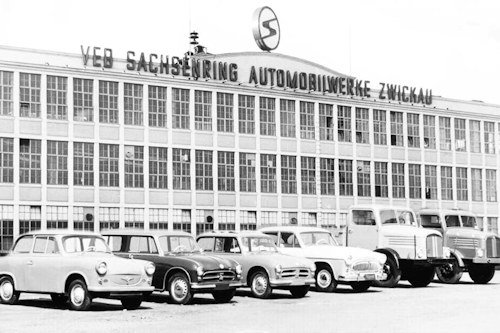VEB Sachsenring
Automotive manufacturer Zwickau, Germany from 1955 to 1969.

HQM Sachsenring GmbH is a Zwickau-based company that supplies chassis and body parts to the automotive industry. The company was named after the Sachsenring race track. Founded as VEB (Volkswagen Betrieb) Sachsenring a Publicly Owned Enterprise after the end of World War II, Sachsenring was one of the only manufacturers of vehicles in the German Democratic Republic, its most famous product being the Trabant along with Commercial vehicles as IFA.
The history of the Sachsenring goes back directly to the plants of Horch (famous for luxury cars) and Audi in Zwickau. Horch was expropriated along with the rest of Auto Union in June 1948 after a referendum. In the same year, the plant was reopened as VEB HORCH Kfz- und Motorenwerke Zwickau as a company in the Vehicle Construction Industry Association (IFA). Initially, the H3 truck and the RS01 tractor were manufactured here. In 1950 production of the newly developed IFA H3A began, for which a diesel engine was used that was also produced in Zwickau.
The Horch factory tried to maintain the tradition of luxury limousines with the P 240 "Sachsenring" (known as Horch "Sachsenring"). The name of the vehicle was transferred to the plant in 1957, which from then on was called VEB Sachsenring Kfz- und Motorenwerk Zwickau. At the same time, the forerunner of the Trabant, the AWZ P 70, was produced at the VEB Automobilwerk Zwickau (AWZ), on which initial experience with body parts made of Duroplast could be gained.
By 1958 to form VEB Sachsenring Automobile Zwickau. Truck production was handed over to the “Ernst Grube” motor vehicle factory in Werdau, with truck diesel engine production remaining in Zwickau until 1965.The new Trabant 601 in 1963 was the last successful new development by the Sachsenring development department. In the 1970s and 1980s, the Trabant was built almost unchanged.
It was not until 1984 that there were signs of progress, which was actually put into practice: as part of a comprehensive cooperation agreement with Volkswagen, the IFA had acquired the license to build the VW Polo engine, which was mass produced in the Barkas works from 1988. Following the reunification of Germany in 1990, Sachsenring transitioned from a government-owned company under a centrally-planned economy to a private corporation in a free market economy. As from 1993 as FES GmbH Fahrzeugentwicklung Sachsen. The plant was sold together with the rights to the name, to the Rittinghaus brothers from Hemer, who wanted to establish the company as an automotive supplier under the name Sachsenring Automobiltechnik GmbH. The company quickly developed into a model company in the new federal states. In 1996 it was converted into a public limited.
Both Sachsenring Fahrzeugtechnik GmbH and Sachsenring AG filed for insolvency on May 30, 2002. After three years in bankruptcy, Sachsenring AG was purchased in February, 2006 by Härterei und Qualitätsmanagement GmbH (HQM) of Leipzig. Formerly the dominant and only major automaker in East Germany, Sachsenring has since departed from making motor vehicles. At the end of August 2014, production ceased in the remaining Mechanical Production division.
Models
1954-1959 P24 Marketed as the Horch P 240 “Sachsenring” until 1957. Engine: in-line six-cylinder four-stroke engine (2,407 cm³, 80 hp), total length: 4,730 mm, mass: 1,480 kg, wheelbase: 2,800 mm, top speed: 140 km/h
1955-1959 P70 "Zwickau “Produced by AWZ as "AWZ P 70 'Zwickau'" until 1958. The P 70 was one of the first production cars with a plastic body. The floor assembly was identical to that of the DKW F 8. Production ended in 1959 in favour of the Trabant.
1957-1962 Trabant(P50) Produced until 1958 as "AWZ P 50 'Trabant'". The P 50 was to be the first mass-produced car in the GDR.
1962-1965 Trabant 600(P60) Identical in construction to the P 50, but with a larger engine (from 500 cm³/18 hp to 600 cm³/23 hp). The station wagon version was produced for two more years until the body of the "Trabant 601 universal" was finished.
1969 representative Following an order from the NVA, five representative vehicles based on the P 240 with a contemporary body were built in 1969 to mark the 20th anniversary of the GDR.
1964-1990 Trabant 601(P601) Floor assembly and engine identical to the P 60, but with a new trapezoidal body, but with old doors and front fenders. Later increase in performance (e.g., crankshaft with needle bearings) to 26 hp.
1957-1958 H3SThe H3S was a revision of the Horch H3A, making it the first truck that Sachsenring-Werke produced.
1959-1960 S4000 S4000-1The "S4000" (S for Sachsenring) had a payload of 4.0 t. It used the same cab as the H3A/H3S and so resembled it in appearance. In 1960, production was relocated to the “Ernst Grube” motor vehicle plant in Werdau. Here the S4000 was further developed into the W50 (W for Werdau). In 1965 the entire production was relocated from Werdau to Ludwigsfelde near Berlin.
1990-1991 Trabant 1.1Sales designation "IFA Trabant 1.1". Body almost identical to the P 601, but with a new bonnet made of sheet steel. Technical improvements to the chassis also due to the use of Volkswagen 's four-stroke licensed engine.


